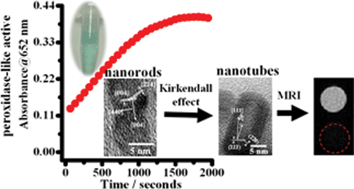Synthesis of magnetic hollow nanotubes based on the kirkendall effect for MR contrast agent and colorimetric hydrogen peroxide sensor†
Abstract
We developed a simple solvothermal approach to synthesize hollow Mn ferrite

* Corresponding authors
a
Department of Chemistry, National Cheng Kung University, Tainan, Taiwan
E-mail:
hplin@mail.ncku.edu.tw
b Center for Translational Research in Biomedicial Science, Chang Gung Memorial Hospital, Kaohsiung, Taiwan
We developed a simple solvothermal approach to synthesize hollow Mn ferrite

 Please wait while we load your content...
Something went wrong. Try again?
Please wait while we load your content...
Something went wrong. Try again?
M. Liao, C. Huang, M. Chang, S. Lin, T. Liu, C. Su, C. Yeh and H. Lin, J. Mater. Chem., 2011, 21, 7974 DOI: 10.1039/C1JM10429B
To request permission to reproduce material from this article, please go to the Copyright Clearance Center request page.
If you are an author contributing to an RSC publication, you do not need to request permission provided correct acknowledgement is given.
If you are the author of this article, you do not need to request permission to reproduce figures and diagrams provided correct acknowledgement is given. If you want to reproduce the whole article in a third-party publication (excluding your thesis/dissertation for which permission is not required) please go to the Copyright Clearance Center request page.
Read more about how to correctly acknowledge RSC content.
 Fetching data from CrossRef.
Fetching data from CrossRef.
This may take some time to load.
Loading related content
